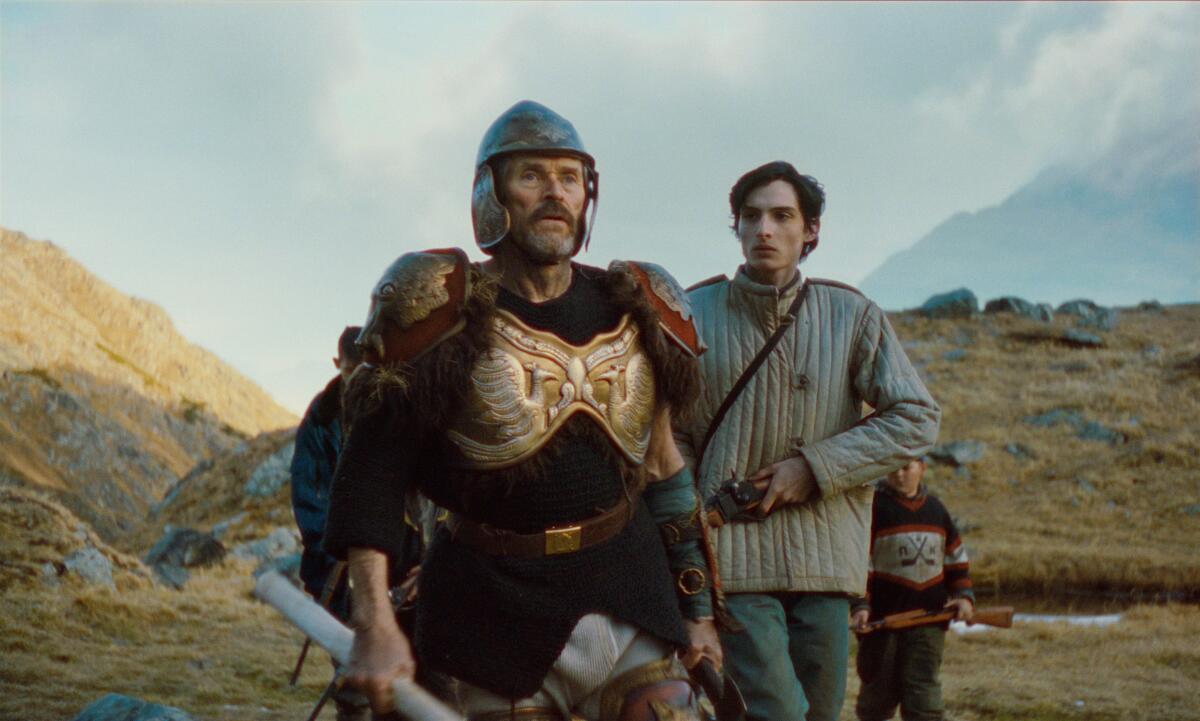A new fantasy film offers a vision for how Californians can coexist with other large mammals

- Share via
As Californians increasingly contend with living among wolves, black bears and mountain lions, an offbeat new fantasy movie reflects many state residents’ anxieties about their proximity to wildlife.
“The Legend of Ochi,” released in theaters nationwide on April 25 and available to stream starting May 20, follows one tween’s quest to return an injured blue-faced baby primate to its home. Twelve-year-old Yuri’s (Helena Zengel) Eastern European community, on the fictional island of Carpathia, has long warred with the fictional animals — called ochi. (Her dad Maxim, played by Willem Dafoe, is a fervent ochi-hater.)
Bucking the inherited notion that ochi are vicious creatures to be destroyed, Yuri finds she has more in common with the creatures than she was taught to believe. Healing the bond between the species also helps her heal bonds within her own species — that of her immediate family.

Isaiah Saxon, raised in Aptos, Calif., wrote and directed the A24-produced film, and watching it, it’s easy to find links to issues facing Californians today. The state is home to what may be the densest population of black bears in the world, a growing number of gray wolves and ample mountain lions in some regions. Not all residents are happy about it.
Beginning in the 1970s, a sea change in state and federal policy allowed large predators to make a comeback across California. Meanwhile, humans have expanded into wild areas while a changing climate can drive animals into the path of people. The increased overlap of man and beast has led to an increase in conflict, according to California wildlife officials.
Ranchers in rural pockets of the state who lose cattle to wolves fear for their livelihood, and a couple told The Times they want to be able to shoot some of the protected canids — to teach them a lesson. Siskiyou and Lassen County leaders are calling on the state to do something about the economic toll the wolves are taking on ranchers, and the California Department of Fish and Wildlife recently approved stronger harassment methods, including assaulting the animals with noise from drones.
Galvanized by recent lethal animal attacks — including the state’s first fatality linked to a black bear in 2023 — California lawmakers have called for harsher methods to ward off wildlife. A state bill originally aiming to allow El Dorado County to use hounds to chase away mountain lions passed a state Senate committee last month, but was changed to lose the dogs. It would now require the state wildlife department to enhance a conflict reduction program in part by engaging in public outreach and offering grant funding for measures to protect livestock. A similar bill permitting the use of dogs to chase black bears away from places where humans decide the bears are unwanted died in a state Assembly committee last month but was granted reconsideration — an opportunity for another vote next year.
But many Californians believe in a different kind of coexistence — one that often centers the rights of animals to inhabit their native territory.
California wolves are on the comeback. And no matter how hard wildlife officials try to direct them toward their natural prey, the wolves seem to find the domesticated cattle wandering through open pastures a lot more appealing.
Speaking to The Times, Saxon said California’s wildlife anxieties weren’t consciously on his mind when he created “Legend of Ochi,” but parallels between the imaginary world of his debut feature film and his home state emerged during a phone interview.
Saxon, who grew up in the redwood forests of Santa Cruz County, recalled a “constant fear of mountain lions” in the community where he was raised. There was also a fervent believer in Sasquatch and a museum in Santa Cruz dedicated to the hirsute, mythical creature.
The 42-year-old recalled being told that “If I wandered off into the woods, far enough away from our house, then Sasquatch or mountain lions, or, you know, real adventure and a real kind of sense of magic [awaited] in the forest. So I think that was somehow deep in me when I was coming up with this story.”
In the mountains he hails from, the community often breaks down into “hippies or rednecks,” said Saxon. The way he describes it, those are crude terms for a more nuanced community divide: “people who want to live symbiotically with nature, and then people who want to use force against it.”
When he was about 6 years old, he’d visit his best friend’s family at a nearby property where he’d see them shooting blue jays for sport. Then he’d return to his home of vegetarians.
Later on in life, he’d see the same dichotomy play out elsewhere in California. Saxon moved to L.A. about a decade ago, and, until the Eaton fire burned his house down, lived in Altadena. Shortly before moving to the foothills community about two and a half years ago, he heard that some of his would-be neighbors had illegally shot a mountain lion accused of slaughtering animals in the neighborhood, including all the goats on the farm next to what would become his home.
Similar acts of vigilante justice animate his film. An opening montage includes a bloodied sheep ostensibly mauled by an ochi. Sometimes the primates bite when afraid. In one scene, Maxim reminds a ragtag gang of young boys he’s trying to raise into skilled hunters what they’re fighting for: Their families have lost geese, cats, livestock, a sense of safety.
Director Isaiah Saxon got his start making otherworldly videos for Grizzly Bear and Björk. For his debut feature, a large team created a creature the old-fashioned way.
Saxon said he understands the impulse to violently retaliate against an animal that’s caused damage, but ultimately stands against it.
“It’s a spiritual choice to not just remove that animal from that situation,” he said. “And by that, what I mean is that you would have to have a respect for the sentience and experience of that mountain lion to not choose to solve it that way.”
The goal of the film, Saxon said, was not just to advocate for not killing wild animals that live near humans. “It’s not just ‘let’s not destroy them.’ It’s ‘we would be better off if we learned from them,’” he said.
In Saxon’s childhood home, Jane Goodall was one of three agreed-upon patron saints. (The others were the Dalai Lama and the Beatles.) And in a recent conversation with Goodall on A24’s podcast, he described his debut feature film as “a critique of anthropocentrism.”
The films reveals the ochi can do things people can’t, like communicating through sensations. And they defy their caricature of red-eyed, bloodthirsty beasts. Sporting globular dark eyes and fuzzy, caramel-colored fur, the baby ochi — a physical puppet that has been likened to a Gremlin and Baby Yoda — is quite cute.
Saxon imbued Yuri’s parents with polarized views on wildlife. Maxim sees humans as apex beings with a right to control the environment. Dasha, Yuri’s mother (played by Emily Watson), has dedicated ample time to studying the ochi, but — according to Saxon — accepts that nature can sometimes be beyond the grasp of human conception.
Whisper-voiced Yuri acts as an audience avatar, not yet solidified in her values but figuring them out on her own.
“My hope with the film is that kids can enter in as curiously and open-mindedly as Yuri is in the film, and make up their own minds and not let adults stand in the way of what they think is right and true,” Saxon said.
Children’s movies featuring animals often reinforce stereotypes that predatory animals are inherently evil. For example, consider the Disney classic “The Little Mermaid” (1989) or the 2004 DreamWorks film “Shark Tale,” both of which show the sharks as menacing, notes a blog for the UC Davis Animal Behavior Graduate Groups. Or Disney’s “Frozen,” from 2013, where wolves gnash as they pursue the heroine.
There are exceptions and it can get messy. “The Lion King,” the 1994 Disney blockbuster, features an apex predator (the titular lion) as the hero — but he has to change his behavior to eat grubs as part of his hero’s journey. Meanwhile, the primary villain is another lion who stays a predator.
Amaroq Weiss, senior wolf advocate for the Center for Biological Diversity, a nonprofit dedicated to protecting endangered animals, believes positive narratives about predators are key at a moment in which people and wildlife are increasingly overlapping, driven by human development and climate change.
“For people who live in towns and cities who are now getting to meet the wild neighbors and not knowing much about them, that’s an easy way to just immediately form a fearful impression of them,” she said, “which why it’s even more important … that we do get the message out to people as as young and early as possible.”











